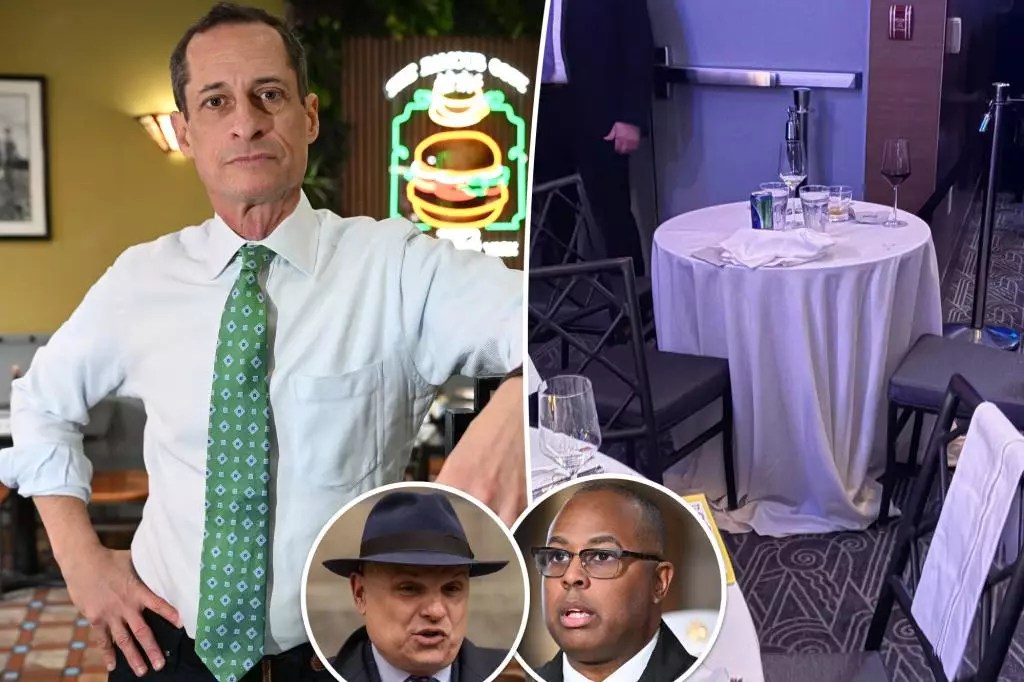Size is more than a mere numerical value in the high-stakes world of New York politics—especially when it comes to social events. The recent Inner Circle dinner, a celebrated annual gala where political and media titans mingle, showcased just how crucial one’s place at the table can be. For disgraced former Congressman Anthony Weiner, this event was a return of sorts, marking his first significant appearance amidst the political elite since his fall from grace. However, the seating arrangement turned a graceful return into a spectacle of mockery, leading to a rather unfortunate and comically humiliating moment—one that illustrates the intricate social hierarchies within political circles.
Rather than being welcomed back into the fold, Weiner found himself assigned to what insiders dismissively termed “the kids’ table.” This misunderstanding seemed less like an innocent gaffe and more like a glaring representation of Weiner’s current standing in the political arena. The derogatory moniker “small Weiner table” was more than just a pun; it highlighted how far Weiner had fallen in the eyes of his peers. While one might expect a grand return, the actual experience was rife with laughter, not just at his expense, but a pointed reminder that appearances matter deeply in social political dynamics.
A Comedy of Errors
The unfolding drama around Weiner’s seating arose when he was abruptly removed from a larger table to occupy a diminutive one set for three, right in front of the stage. As he confided to the media later, being moved to this lesser table felt bewildering. Interestingly, it points to a more significant issue of organizations’ logistical shortcomings that occasionally overshadow the events themselves. Weiner’s swift exit after the intermission added another layer to this curious incident. According to reports, his departure was met with a mixture of laughter and disbelief—an unintentional comedy that only fueled the fire surrounding his controversial persona.
Despite the chaos of the evening, Weiner attempted to paint a calm picture of the mishap in his communications, insisting that he had no preoccupation with the seating chaos. He attributed his early departure to a desire to spend time with his son rather than feelings of embarrassment. Here, one can’t help but notice that while his words paint a picture of a man unfazed by social ridicule, the optics of the situation tell a different story. Was he truly unfazed, or had he conditioned himself to wield humor as a coping mechanism in response to social ostracism?
The Friends Who Stay Together
Amidst the humiliating turn of events, Weiner’s longtime friend and defense attorney, Arthur Aidala, stood by him. Aidala’s unfettered support suggested more than just camaraderie; it reflected a complicated network of relationships within the New York political scene that often thrives on loyalty amidst scandal. His assurance that the seating mishap was merely an oversight speaks volumes about the way the New York political elite manage social affairs with the same precision as a high-stakes game of chess. In a city where image is everything, making amends can often mean navigating social gaffes with a smile—or, in Weiner’s case, a quick retreat.
One of the most telling aspects of this interaction is Aidala’s unwavering belief in Weiner’s potential comeback, describing him as “intriguing” and a “great conversationalist.” Such statements not only showcase Aidala’s loyalty but also raise the question of redemption in political culture. Are the public and the media willing to allow for the reintegration of a figure who once caused such strife? Aidala’s continued friendship suggests that behind every public disgrace lies a contested journey of personal redemption—a narrative rarely afforded to figures like Weiner, despite the passage of time.
The Inner Circle: A Reflective Microcosm of Politics
The Inner Circle dinner serves an important role beyond its facade of humor and glamour; it reflects the power structures and social dynamics that characterize the grimy underbelly of politics. While the event traditionally offers levity through comedic roasts aimed at the city’s most notable figures—this year’s victims included Mayor Eric Adams and former Governor Andrew Cuomo—the backdrop of laughter starkly contrasts the serious implications of social positioning. It turns out this annual gathering isn’t just about charity and socializing; it’s a careful reaffirmation of hierarchies that often shape one’s career in the politically charged atmosphere of New York.
In an era where political narratives are frequently smeared by public perception and media portrayal, Weiner’s experience serves as a cautionary tale about how past misdeeds can reduce a man to the peripheries of social acceptance. Yet in the intricate dance of New York politics, perhaps what Weiner learned on this night is that while seating may matter, the true game is about relationships—how to navigate, sustain, or revitalize them amidst scandal’s looming shadow.







Leave a Reply